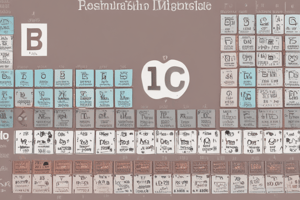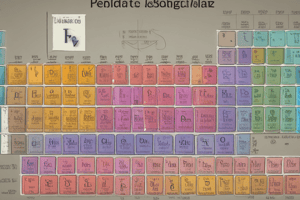Podcast
Questions and Answers
What are some physical properties of elements?
What are some physical properties of elements?
Density, color, and luster
How are elements arranged in the periodic table?
How are elements arranged in the periodic table?
According to increasing atomic number
Where are metals located on the periodic table?
Where are metals located on the periodic table?
On the left side
What are the properties of metals?
What are the properties of metals?
What are the three categories into which scientists classify metals?
What are the three categories into which scientists classify metals?
Name two alkaline earth metals.
Name two alkaline earth metals.
What are the properties of metalloids?
What are the properties of metalloids?
Why are metalloids like silicon used in machines, computer chips, and electrical circuits?
Why are metalloids like silicon used in machines, computer chips, and electrical circuits?
What are the properties of nonmetals?
What are the properties of nonmetals?
What are noble gases and why are they called noble gases?
What are noble gases and why are they called noble gases?
Give an example of a noble gas and its use.
Give an example of a noble gas and its use.
Which non-metallic trace elements are found in the halogens group?
Which non-metallic trace elements are found in the halogens group?
Flashcards are hidden until you start studying
Study Notes
Transition Metals
- Located in the middle of the periodic table
- Include elements such as copper, iron, gold, nickel, and zinc
- Hard and shiny
- Slowly react with other materials
- Used to make jewelry, machines, and other materials
Metalloids and Nonmetals
- Metalloids are located on the right side of the periodic table
- Share properties with both metals and nonmetals
- Include elements such as silicon, boron, and arsenic
- Semiconductors of electricity, conducting electricity at high temperatures but not at low temperatures
- Used in machines, computer chips, and electrical circuits
Nonmetals
- Have properties opposite to those of metals
- Found in the right side of the periodic table
- Include elements such as oxygen, carbon, and nitrogen
- At room temperature, most nonmetals are gases or brittle solids that break easily
- Do not conduct heat and electricity
Noble Gases
- Located in the last column to the right of the periodic table
- Do not react with other elements under normal conditions
- Include elements such as argon, neon, xenon, and helium
- Used in various applications such as light bulbs, car headlights, and balloons
Halogens
- Located to the left of the noble gases
- Include non-metallic trace elements such as fluorine and chlorine
- Chlorine is an active nonmetal that binds with sodium to form sodium chloride (table salt)
Physical and Chemical Properties of Elements
- Elements have physical properties such as density, color, and luster
- Elements also have chemical properties that describe how they react with other substances
- Elements in the same region of the periodic table have similar properties
Metals
- Located on the left side of the periodic table
- Properties include being shiny, bending easily, and conducting heat and electricity
- Classified into three categories: alkali metals, alkaline earth metals, and transition metals
- Alkali metals are soft, easily form compounds, and do not exist alone in nature
- Alkaline earth metals are light, essential for many living creatures, and include elements such as calcium and magnesium
Studying That Suits You
Use AI to generate personalized quizzes and flashcards to suit your learning preferences.




